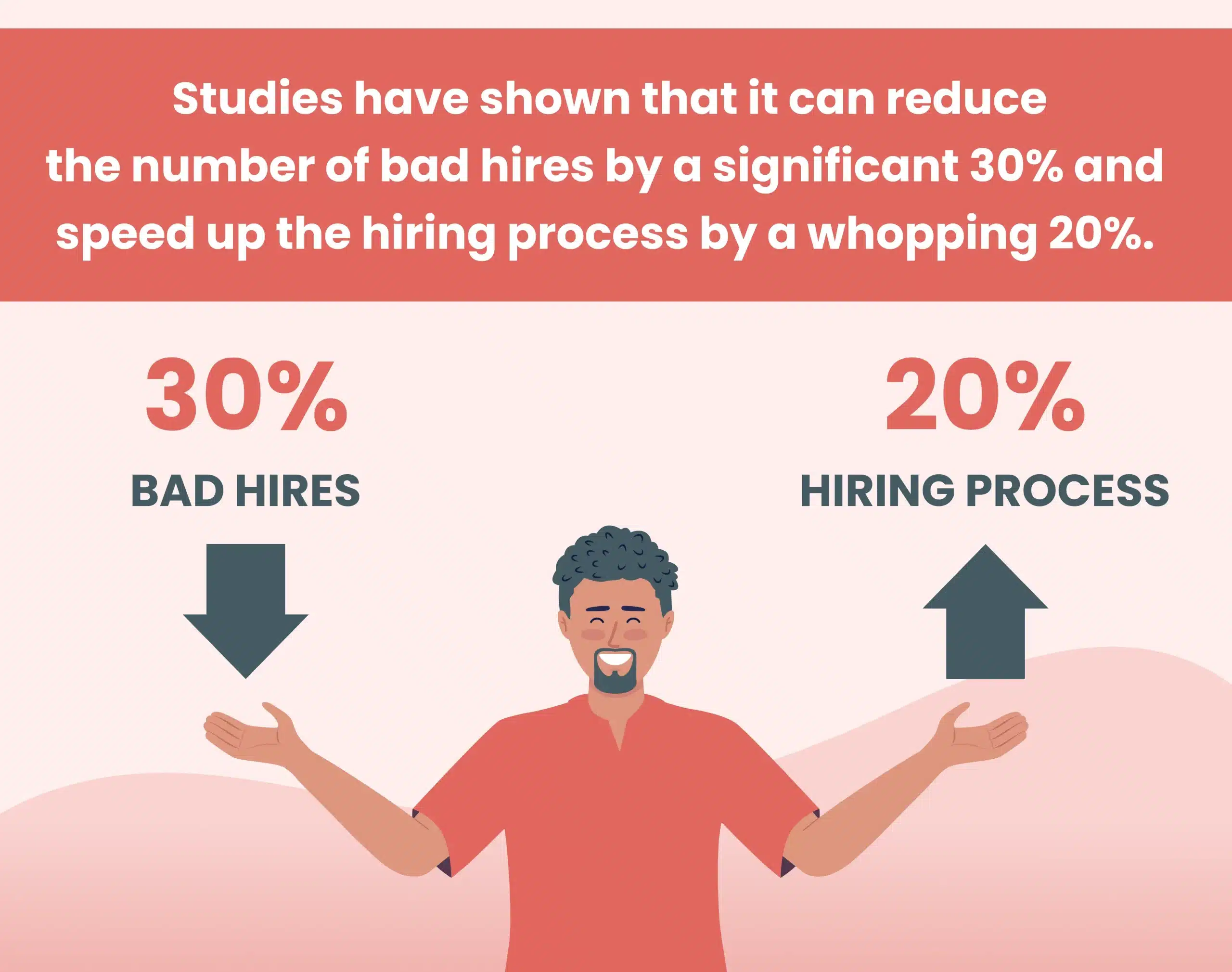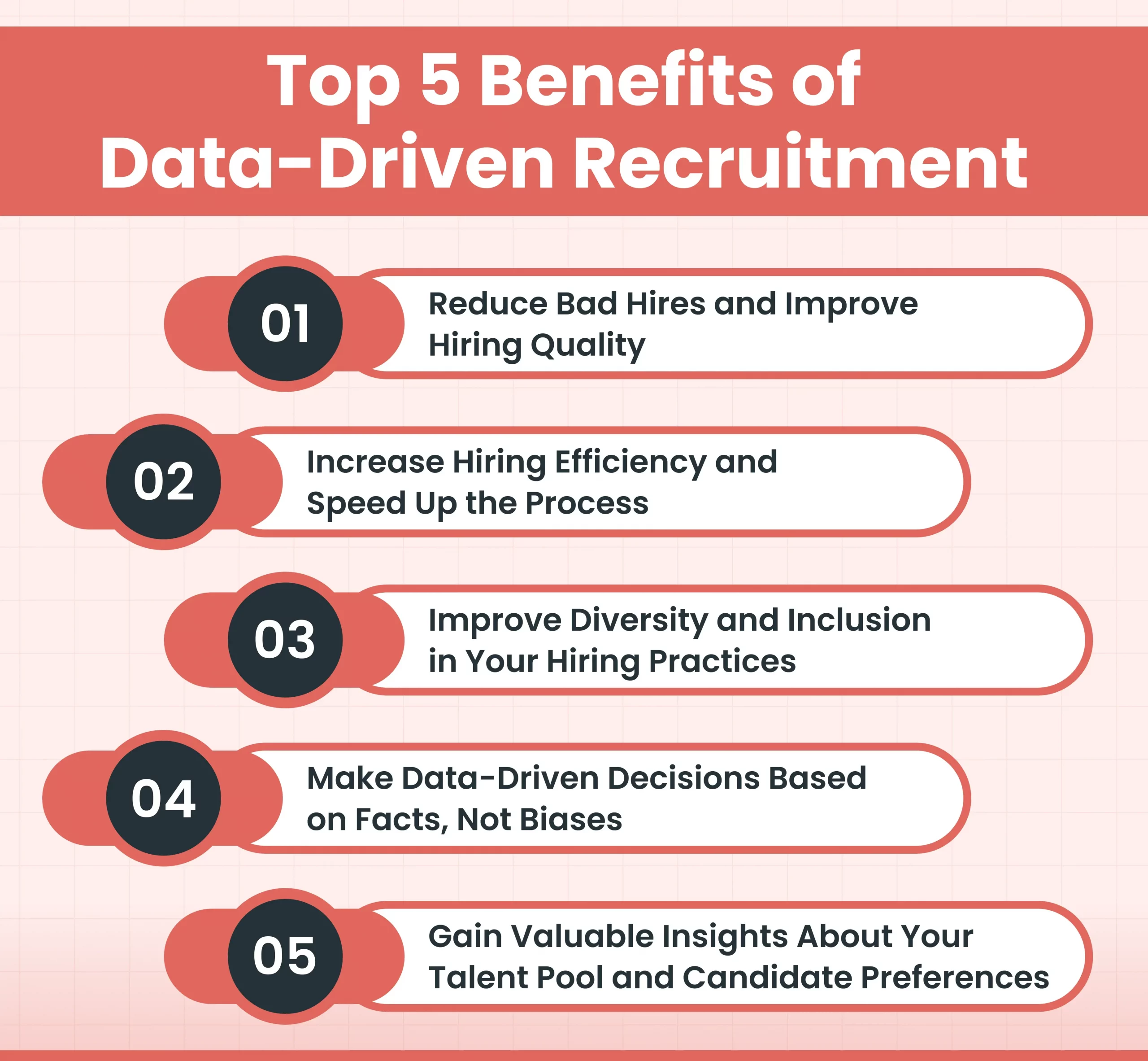Table of content
Data-driven recruitment is a game-changing move to enhance the quality of hire. It involves using objective data to make hiring decisions, eliminating the pitfalls of subjective measures like gut feelings or personal biases. By analyzing job performance metrics and candidate assessments, recruiters can identify the most qualified candidates and make more informed hiring decisions. The results speak for themselves. Studies have shown that it can reduce the number of bad hires by a significant 30% and speed up the hiring process by a whopping 20%.
If you’re ready to stop relying on guesswork and build a strong and confident team, this blog will show you how data-driven recruitment can help.
Hiring Fails: Why Gut Feeling Isn’t Enough Anymore
Relying solely on gut feeling during hiring can lead to costly mistakes. Let’s explore why gut feeling isn’t enough when hiring top talents for your team!
Relying on Gut Feeling and Intuition
Relying solely on gut feeling and intuition during hiring can be tempting. After all, many recruiters believe in their instincts and feel they can accurately judge a candidate’s potential based on a brief interaction or a resume. However, studies have shown that relying on intuition can be unreliable. Human biases, personal preferences, and unconscious prejudices can cloud judgment, leading to hiring decisions that may not always be in the company’s best interest. While intuition can sometimes be helpful, it should not be the only factor considered when hiring.
The High Cost of Bad Hires
Making a bad hire can be costly for a company in more ways than one. Not only does it impact team morale and productivity, but it also results in financial losses. The cost of recruiting, onboarding, training, and then replacing a bad hire can add up quickly. Additionally, bad hires can lead to disruptions in workflow, missed opportunities, and potential damage to the company’s reputation. Therefore, organizations need to minimize the risk of bad hires by improving their hiring processes and making more informed decisions.
Inefficiency in the Traditional Hiring Process
The traditional hiring process is a time-consuming and inefficient ordeal. It often involves posting a job opening, reviewing resumes, conducting interviews, and deciding based on limited information. This approach can be a real headache and may only sometimes result in finding the best candidate for the job. Recruiters and hiring managers often spend countless hours sifting through resumes and conducting interviews, only to realize they have yet to find the right fit.
Beyond Resumes: Introducing Data-Driven Recruitment for the Modern Recruiter
Modern recruiters need to move beyond resumes and adopt data-driven recruitment strategies. By leveraging data and analytics, recruiters can make more informed decisions about who to hire and streamline the hiring process.
What is Data-Driven Recruitment?
Data-driven recruitment is a modern approach to hiring that leverages data analytics, technology, and insights to make more informed and effective hiring decisions. Unlike traditional recruitment methods that rely heavily on intuition and gut feeling, data-driven recruitment focuses on objective data and metrics to identify suitable candidates for the job. By harnessing the power of data, recruiters and hiring managers can improve the accuracy of their candidate assessments, reduce hiring bias, and, ultimately, make better hiring decisions. The benefits of data-driven recruitment are significant, offering organizations a competitive edge in attracting top talent and building high-performing teams.
How Does Data-Driven Recruitment Work?
Data-driven recruitment collects, analyzes, and interprets various data types to optimize the hiring process. Here are some key aspects of how data-driven recruitment operates:
- Applicant Tracking Systems (ATS): These software tools help recruiters manage and track job applications. ATS systems can analyze resumes, screen candidates based on specific criteria, and more efficiently identify top talent.
- Predictive Analytics: This involves using historical data to forecast future hiring needs and candidate success. Predictive analytics can help recruiters prioritize candidates likely to perform well and stay with the company long-term.
- Skill Assessments and Tests: Utilizing data-driven skill assessments and tests can provide objective insights into a candidate’s abilities, knowledge, and fit for the role.
- Interview Analytics: Tools that analyze interview performance and feedback can help recruiters identify areas of improvement in the interview process and make more objective hiring decisions.
Top 5 Benefits of Data-Driven Recruitment
Data-driven recruitment transforms how organizations approach hiring, offering a range of benefits that can significantly impact recruitment outcomes. Let’s explore the top five benefits of data-driven recruitment.
Benefit #1: Reduce Bad Hires and Improve Hiring Quality
One of the most compelling benefits of data-driven recruitment is its ability to reduce bad hires and enhance the overall quality of hires. According to studies, bad hires can cost companies up to 30% of the employee’s first-year earnings. Organizations can more accurately assess a candidate’s skills, experience, and fit for the role by leveraging data analytics and predictive analytics tools. This leads to better hiring decisions, resulting in higher employee retention rates and improved organizational performance.
Benefit #2: Increase Hiring Efficiency and Speed Up the Process
Data-driven recruitment significantly improves hiring efficiency by automating repetitive tasks like resume screening and candidate matching. On average, organizations using data-driven recruitment experience a 20-30% reduction in time-to-hire. By streamlining the recruitment process, recruiters can focus on more strategic tasks, such as interviewing and candidate engagement, thereby accelerating the hiring process.
Benefit #3: Improve Diversity and Inclusion in Your Hiring Practices
Data-driven recruitment plays a crucial role in promoting diversity and inclusion within organizations. By analyzing recruitment data, organizations can identify and address biases in their hiring practices. For instance, data analytics can help recruiters track diversity metrics, such as gender, ethnicity, and age, and ensure that diverse candidates are being considered and hired. This not only fosters a more inclusive work environment but also brings a variety of perspectives and ideas to the table, driving innovation and creativity.
Benefit #4: Make Data-Driven Decisions Based on Facts, Not Biases
One key benefit of data-driven recruitment is the ability to make objective, fact-based decisions. Unlike traditional recruitment methods, which can be influenced by biases and personal preferences, data-driven recruitment relies on data and analytics to guide decision-making. This ensures hiring decisions are fair, consistent, and aligned with the organization’s goals and values.
Benefit #5: Gain Valuable Insights About Your Talent Pool and Candidate Preferences
Data-driven recruitment gives organizations valuable insights into their talent pool and candidate preferences. By analyzing candidate data and feedback, organizations can identify trends, patterns, and preferences that inform their recruitment strategies. For example, understanding which sourcing channels yield the best candidates or which benefits are most valued by potential hires can help organizations refine their recruitment marketing efforts and attract top talent more effectively.
Getting Started with Data-Driven Recruitment
Let’s learn how to implement data-driven recruitment by following the right approach, using the right tools, and devising a smart strategy.
Identify the Data You Need to Collect for Recruitment
The first step in implementing data-driven recruitment is identifying the data types that are relevant and valuable for your hiring process. Some key data points to consider include:
- Skills and Qualifications: Look into the candidate’s relevant skills, certifications, and educational background to ensure they fit the role perfectly.
- Performance Metrics: Check the past performance reviews, KPIs, and achievements to get better insights about the candidate.
- Sourcing Channels: Analyze information about the sources from which the candidates are coming, such as job boards, social media, or referrals.
- Hiring Costs: Please note the following recruitment metrics: cost per hire, time-to-hire, and any other relevant metrics that may be useful in evaluating the recruitment process.
By collecting and analyzing these data points, organizations can gain insights into their recruitment process, identify areas for improvement, and make more informed hiring decisions.
Utilizing Applicant Tracking Systems (ATS) and Other Relevant Tools
An Applicant Tracking System (ATS) is a valuable tool for data-driven recruitment. ATS systems help recruiters manage, track, and analyze job applications, making collecting and storing recruitment data easier. Additionally, other relevant tools, such as predictive analytics software, skill assessment platforms, and interview analytics tools, can further enhance the data-driven recruitment process.
Utilizing these tools allows organizations to automate manual tasks, streamline recruitment processes, and gain actionable insights from recruitment data. This improves efficiency and enables organizations to leverage the benefits of data-driven recruitment effectively.
Building a Data-Driven Recruitment Strategy for Your Company
Building a data-driven recruitment strategy involves creating a structured approach to collecting, analyzing, and utilizing recruitment data to achieve your hiring goals. Here are some steps to help you build a data-driven recruitment strategy:
- Define Your Objectives: Clearly outline your recruitment goals and objectives, such as reducing time-to-hire, improving candidate quality, or increasing diversity.
- Identify Key Metrics: Determine the key performance indicators (KPIs) and metrics that align with your objectives. These could include metrics like cost per hire, quality of hire, or diversity hiring rates.
- Implement Data Collection Processes: Establish processes for collecting and storing recruitment data. Ensure data is accurate, consistent, and compliant with privacy regulations.
- Analyze and Interpret Data: Use analytics tools to analyze recruitment data and gain insights into your recruitment process. Identify trends, patterns, and areas for improvement.
- Iterate and Optimize: Continuously monitor and evaluate your data-driven recruitment strategy, making adjustments to optimize performance and achieve your goals.
By following these steps and building a robust data-driven recruitment strategy, organizations can harness the power of data to improve their recruitment outcomes, enhance efficiency, and realize the benefits of data-driven recruitment.
Conclusion
Data-driven recruitment offers organizations significant advantages in today’s competitive talent market. By reducing bad hires, improving hiring efficiency, enhancing diversity, and gaining insights into candidate preferences, the benefits of data-driven recruitment are clear. Utilizing tools like Applicant Tracking Systems (ATS) and building a structured data-driven recruitment strategy are key steps to harnessing these benefits. Adopting data-driven recruitment enables organizations to optimize their hiring process, attract top talent, and achieve better recruitment outcomes.
If you’re looking to hire top IT professionals for your team, then Supersourcing can help! We have a pool of the best software developers who are fit for every specific need. Contact us today to learn more



